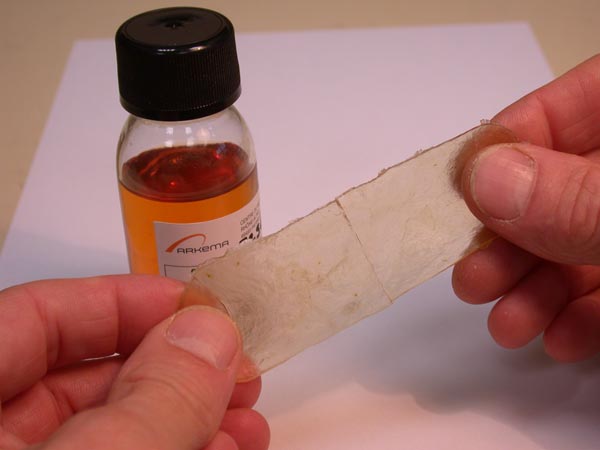What is Self-Healing Material?
Self-healing materials are a class of smart materials that have the structurally incorporated ability to repair damage caused by mechanical usage over time. The inspiration comes from biological systems, which have the ability to heal after being wounded. Initiation of cracks and other types of damage on a microscopic level has been shown to change thermal, electrical, and acoustical properties, and eventually lead to whole scale failure of the material.
 Self Healing Rubber
Self Healing Rubber
Usually, cracks are mended by hand, which is difficult because cracks are often hard to detect. A material (polymers, ceramics, etc.) that can intrinsically correct damage caused by normal usage could lower production costs of a number of different industrial processes through longer part lifetime, reduction of inefficiency over time caused by degradation, as well as prevent costs incurred by material failure. For a material to be defined as self-healing, it is necessary that the healing process occurs without human intervention. Some examples shown below include healing polymers that are not “self-healing” polymers.
From a molecular perspective, traditional polymers yield to mechanical stress though cleavage of sigma bonds. While newer polymers can yield in other ways, traditional polymers typically yield through homolytic or heterolytic bond cleavage. The factors that determine how a polymer will yield include: type of stress, chemical properties inherent to the polymer, level and type of solvation, and temperature.
Self-Healing Plastic
From a macromolecular perspective, stress induced damage at the molecular level leads to larger scale damage called microcracks. A microcrack is formed where neighboring polymer chains have been damaged in close proximity, ultimately leading to the weakening of the fiber as a whole.
Halochromic Material
A halochromic material is a material which changes colour when pH changes occur. The term ‘chromic’ is defined as materials that can change colour reversibly with the presence of a factor. In this case, the factor is pH. The pH indicators have this property.
Nature Halochromic
Halochromic substances are suited for use in environments where pH changes occur frequently, or places where changes in pH are extreme. Halochromic substances detect alterations in the acidity of substances, like detection of corrosion in metals.
A halochromic material is a material which changes colour when pH changes occur
Halochromic substances may be used as indicators to determine the pH of solutions of unknown pH. The colour obtained is compared with the colour obtained when the indicator is mixed with solutions of known pH. The pH of the unknown solution can then be estimated. Obvious disadvantages of this method include its dependency on the colour sensitivity of the human eye, and that unknown solutions that are already coloured cannot be used.
Halochromic substances are suited for use in environments where pH changes occur frequently
The colour change of halochromic substances occur when the chemical binds to existing hydrogen and hydroxide ions in solution. Such bonds result in changes in the conjugate systems of the molecule, or the range of electron flow.
This alters the amount of light absorbed, which in turn results in a visible change of colour. Halochromic substances do not display a full range of colour for a full range of pH because, after certain acidities, the conjugate system will not change. The various shades result from different concentrations of halochromic molecules with different conjugate systems.
You might also like
| Smart Material : Ferrofluid What is Ferrofluid ? A ferrofluid (portmanteau... | Smart Materials What are Smart Materials ? Smart materials are... | Smart Materials : Dielectric Elastomers What is Dielectric Elastomers ? Dielectric... | Biomaterials What is Biomaterial ? A biomaterial is... |

 Alloy Suppliers
Alloy Suppliers
 Aluminum
Aluminum
 Aluminum Extrusions
Aluminum Extrusions
 Copper-Brass-Bronze
Copper-Brass-Bronze
 Nickel
Nickel
 Magnets
Magnets
 Stainless Steel
Stainless Steel
 Stainless Steel Tubing
Stainless Steel Tubing
 Steel Service Centers
Steel Service Centers
 Titanium
Titanium
 Tungsten
Tungsten
 Wire Rope
Wire Rope